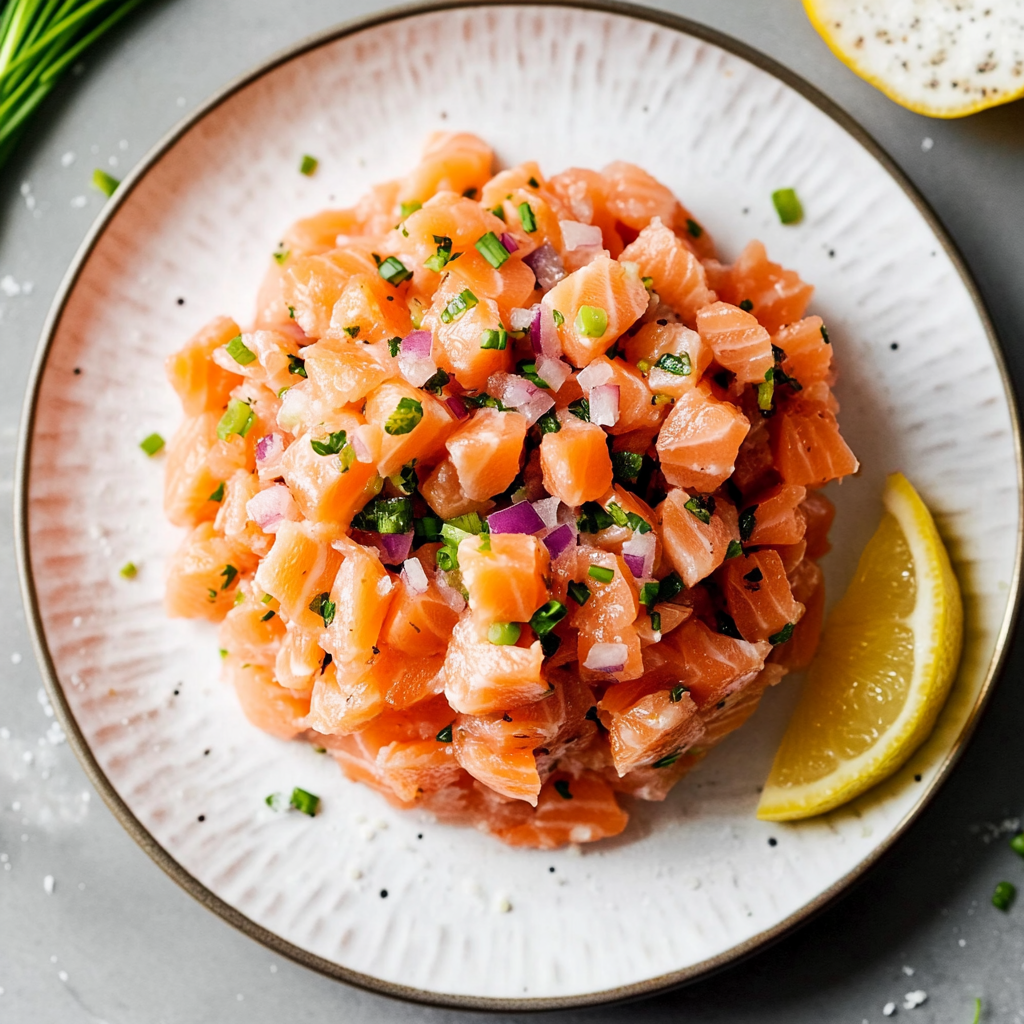This Salmon Tartare is a fresh and vibrant dish that combines the richness of sushi-grade salmon with the briny pop of capers and the bright zing of lemon. It’s ideal for a warm evening or a sophisticated starter at your next dinner party.
With just a handful of ingredients and zero cook time, it’s a foolproof way to bring elegance to your table in minutes. The chives and jalapeño add just the right amount of depth and heat. Serve it chilled for the best experience, and enjoy every refreshing bite.
Full Recipe
Ingredients:
-
1 lb sushi-grade fresh salmon, skin removed
-
1 tablespoon olive oil
-
¼ small red onion, finely diced (about 3 tablespoons)
-
1 tablespoon capers, drained and roughly chopped
-
½ small jalapeño, finely diced (adjust to taste)
-
1 teaspoon Dijon mustard
-
1 lemon (zest and juice)
-
2 teaspoons fresh chives, thinly sliced
-
Salt and freshly ground black pepper, to taste
Directions:
-
Optional: Place the salmon in the freezer for about 15 minutes to firm up, making it easier to dice.
-
Pat the salmon dry with a paper towel. Cut into ¼-inch thick planks, then into ¼-inch strips, and finally into ¼-inch cubes. Transfer to a medium bowl.
-
Add olive oil, red onion, capers, jalapeño, Dijon mustard, lemon zest, lemon juice, and chives to the salmon. Mix well to combine.
-
Let the mixture sit for 5–10 minutes to allow flavors to meld. Taste and adjust seasoning with salt or black pepper if needed.
-
Serve immediately, optionally using a ring mold for a polished presentation. Enjoy with crackers, crostini, or salad greens.
Prep Time: 15 minutes | Cooking Time: 0 minutes | Total Time: 15 minutes
Kcal: Approximately 210 kcal per serving | Servings: 4 servings
Introduction to Salmon Tartare
Salmon tartare is a sophisticated and refreshing dish that has been celebrated in culinary cultures around the world for its vibrant flavors, elegant presentation, and health benefits. It is a no-cook recipe that showcases the quality of fresh, sushi-grade salmon, allowing its natural richness and buttery texture to shine. When paired with bright citrus notes, briny capers, sharp red onions, and subtle herbs, salmon tartare becomes a balanced and flavorful dish that works beautifully as an appetizer or a light entrée.
This dish has gained immense popularity in modern cuisine, not only because of its stunning appearance but also due to its simplicity and versatility. Unlike traditional tartare, which is often associated with beef, salmon tartare introduces a lighter, ocean-inspired version that feels more delicate, yet equally satisfying. Whether served with crostini, crackers, cucumber slices, or avocado halves, it elevates any dining occasion with minimal effort.
The History and Origin of Tartare
The idea of raw, finely chopped meat or seafood can be traced back to ancient times. While beef tartare has strong roots in French cuisine, fish tartares gained global recognition through the fusion of French techniques with Japanese ingredients, especially in upscale restaurants during the late 20th century. Salmon tartare, specifically, emerged as a Western interpretation of sashimi and poke, combining raw fish with European seasonings and dressings.
This blending of culinary traditions created an elegant, refreshing dish perfect for entertaining or indulging in a refined dining experience at home. Over time, chefs have experimented with different herbs, aromatics, and acids to bring out the most nuanced flavors from the salmon, creating variations that range from Mediterranean-inspired to Asian-fusion styles.
Why Quality Ingredients Matter
Since salmon tartare is a raw preparation, the most important factor in creating a successful dish is the quality of the ingredients. The salmon must be sushi-grade, which means it has been frozen to a specific temperature to eliminate any potential parasites. This ensures safety without compromising the delicate flavor and texture of the fish.
Freshness is non-negotiable. The fish should smell clean, almost ocean-like, and should be firm to the touch with a rich, vibrant color. In addition to the fish, ingredients like lemon juice, Dijon mustard, red onion, and capers should also be as fresh as possible, as they provide the acidity and contrast needed to balance the dish. Even a minor compromise in quality can result in a dull or unpleasant tartare.
Texture and Flavor Profile
One of the standout features of salmon tartare is its exceptional texture. The hand-cut salmon has a soft, melt-in-your-mouth feel that is not only luxurious but also satisfying. Unlike cooked salmon, which can become flaky or dry, raw salmon in tartare form retains its natural oils, giving it a smooth and supple consistency.
Flavor-wise, the tartare is bright and punchy. The lemon juice offers citrusy sharpness, the Dijon mustard provides a subtle kick of tang, and the capers add bursts of briny flavor that cut through the richness of the fish. Red onion contributes a crunchy texture and a mild sweetness, while fresh chives offer a gentle herbaceous note that ties all the flavors together.
Health Benefits of Salmon Tartare
From a nutritional perspective, salmon tartare is not just delicious — it’s incredibly good for you. Salmon is rich in high-quality protein and omega-3 fatty acids, which are known to support heart health, reduce inflammation, and improve brain function. It also contains a variety of vitamins and minerals such as vitamin D, vitamin B12, selenium, and potassium.
Because the dish is raw and not cooked in oil or butter, it retains all of its natural nutrients without any added fats or calories. It’s an excellent option for those following keto, paleo, gluten-free, or dairy-free diets. Plus, the raw preparation supports nutrient density, making this dish ideal for health-conscious eaters who don’t want to compromise on flavor.
Serving Ideas and Presentation Tips
Presentation is key when it comes to tartare, especially if you’re entertaining guests or showcasing the dish in a professional or blog setting. A popular method is to use a ring mold to shape the tartare into a neat, compact disk on the plate. This creates an upscale restaurant-style appearance with minimal effort.
You can garnish the dish with microgreens, edible flowers, or an extra drizzle of olive oil. Serve it with crunchy crostini, seeded crackers, or cucumber rounds for contrast. Some like to pair it with avocado for added creaminess, or even serve it on small spoons for a passed hors d’oeuvre at cocktail parties.
For a slightly more filling presentation, consider placing a scoop of tartare atop a salad of arugula or watercress dressed in a light vinaigrette. This keeps the dish light and fresh while offering a beautiful color contrast.
Variations to Explore
While the classic salmon tartare is a balanced and proven recipe, there’s plenty of room for creativity:
-
Asian-Inspired Tartare: Add ingredients like soy sauce, sesame oil, wasabi, and scallions for an umami-rich version.
-
Mediterranean Style: Mix in sun-dried tomatoes, olives, and fresh dill for a flavor reminiscent of coastal Europe.
-
Tropical Twist: Combine diced mango, avocado, and a splash of lime for a sweet-savory tartare with island vibes.
-
Spicy Fusion: Use sriracha, yuzu kosho, or finely diced habanero for a version that brings serious heat.
These twists allow you to customize the dish based on your personal preferences, dietary needs, or the ingredients you have on hand.
Common Mistakes to Avoid
While the dish is simple, there are a few common pitfalls that can affect the outcome:
-
Using low-quality or improperly stored salmon: This is a major food safety concern and can also result in poor texture and flavor.
-
Over-mixing: The salmon should be gently folded with the other ingredients, not mashed. Overworking the mixture can damage the delicate cubes of fish.
-
Adding acid too early: If you’re not serving the tartare immediately, wait to add the lemon juice. Acid can begin to “cook” the fish, changing the texture.
-
Skipping the chill time: Giving the dish a few minutes to sit after mixing allows the flavors to meld together beautifully.
Being mindful of these factors will ensure that your salmon tartare is both safe to eat and stunning to serve.
Ideal Occasions to Serve Salmon Tartare
Salmon tartare is incredibly versatile when it comes to serving occasions. It’s perfect for:
-
Elegant dinner parties or holiday meals
-
Summertime gatherings where no-cook recipes are ideal
-
Special date nights at home
-
Gourmet meal preps for those who enjoy fine food on a regular basis
-
Appetizers at cocktail receptions or celebratory brunches
Its visual appeal and rich taste make it a conversation-starter dish that feels like a treat, yet it requires minimal ingredients and time to prepare.
Pairing Ideas
To complete the experience, pair salmon tartare with beverages that complement its bright, clean flavors. Dry white wines like Sauvignon Blanc, Pinot Grigio, or Champagne are excellent choices. If you prefer beer, opt for a crisp lager or a light pilsner. For a non-alcoholic option, sparkling water with a splash of citrus or a ginger-lime mocktail will work beautifully.
Conclusion
Salmon tartare is a dish that brings together elegance, simplicity, and nutritional value in every bite. With high-quality ingredients and just a few minutes of prep, you can create a restaurant-worthy experience at home that’s as visually stunning as it is satisfying. From its smooth texture to its bold yet balanced flavors, this dish is a shining example of how less can be more in the culinary world.
Whether you’re hosting a dinner party or just treating yourself to something special, salmon tartare is a timeless choice that will never go out of style. With endless variations, clean ingredients, and an undeniable wow factor, it’s a staple recipe every home cook should master.






